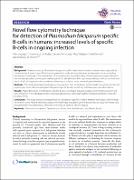| dc.description.abstract | Background: Malaria caused by Plasmodium falciparum is still a major health threat in endemic areas especially for
children below 5 years of age. While it is recognized that antibody immunity plays an important role in controlling
the disease, knowledge of the mechanisms of sustenance and natural boosting of immunity is very limited. Before, it
has not been possible to investigate malaria specific B-cells directly in flow cytometry, making it difficult to know how
much of a B cell response is due to malaria, or how much is due to other immunological stimulators.
Methods: This study developed a technique using quantum dots and schizont extract made from ghosts of infected
erythrocytes, to be able to investigate P. falciparum specific B-cells, something that has never been done before.
Results: Major differences in P. falciparum specific B-cells were found between samples from immune (22.3 %) and
non-immune (1.7 %) individuals. Samples from parasite positive individuals had the highest proportions of specific
B-cells (27.9 %).
Conclusion: The study showed increased levels of P. falciparum-specific B-cells in immune individuals, with the highest
levels in active malaria infections, using a new technique that opens up new possibilities to study how these cells
are sustained in vivo after natural infections. It will also be useful in vaccine studies.
Keywords: Plasmodium falciparum, Quantum dots, Ghost infected red blood cells, Malaria, B-cells | en_US |

